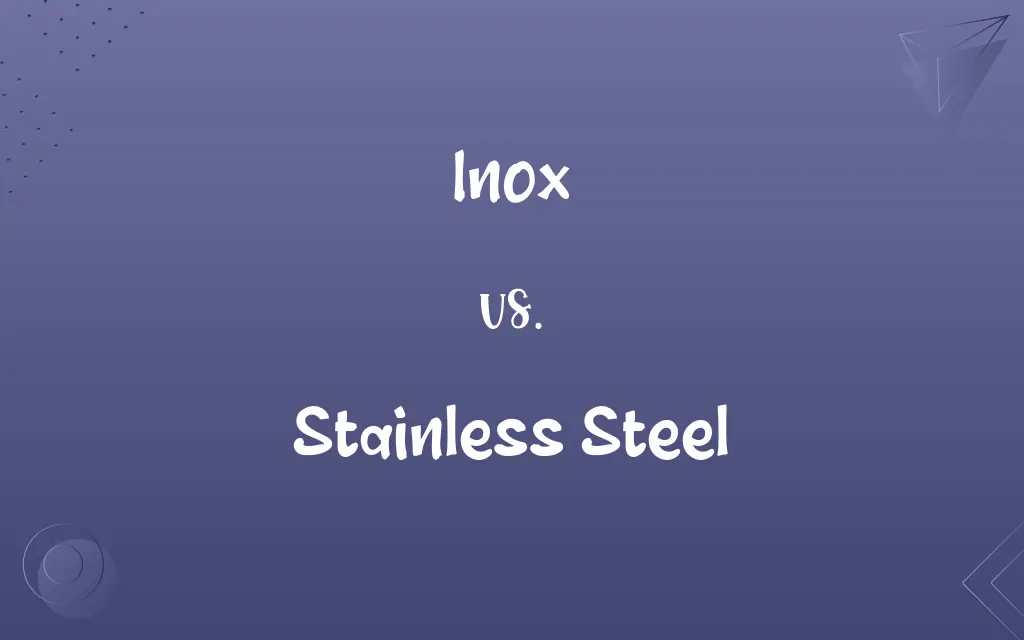Inox vs. Stainless Steel: Know the Difference

By Shumaila Saeed || Published on January 10, 2024
Inox is a synonym for stainless steel, used mainly in Europe, while stainless steel is a corrosion-resistant alloy containing chromium.

Key Differences
resistance to oxidation. Stainless steel, on the other hand, is a broad term for a range of iron-based alloys that are resistant to rust and tarnishing due to the inclusion of chromium. Both terms essentially describe the same material, but "inox" highlights its anti-corrosive qualities.
Shumaila Saeed
Jan 10, 2024
Inox is widely used in European languages to denote stainless steel, focusing on its ability to withstand corrosive environments. The term stainless steel, used predominantly in English-speaking countries, describes the same material but emphasizes its clean, unstained appearance. Both inox and stainless steel are popular in applications where both durability and aesthetics are important.
Shumaila Saeed
Jan 10, 2024
When referring to inox, the emphasis is often on the material's suitability for food industry applications, where hygiene and corrosion resistance are paramount. Stainless steel, while identical in composition, is often associated with a wider range of uses, including architecture, automotive parts, and surgical instruments. This difference in connotation between inox and stainless steel is subtle but notable.
Shumaila Saeed
Jan 10, 2024
In marketing contexts, inox is sometimes used to convey a sense of European quality and sophistication, particularly in kitchen appliances and cutlery. Conversely, stainless steel is a more common term in American and global markets, known for its strength and versatility. Despite these differences in usage, inox and stainless steel refer to the same corrosion-resistant alloy.
Shumaila Saeed
Jan 10, 2024
In technical specifications, "inox" might be used interchangeably with specific stainless steel grades, especially in European standards. Meanwhile, stainless steel in technical contexts usually includes a grade number, like 304 or 316, which specifies the alloy's composition in more detail. Both terms, though culturally distinct, refer to a material prized for its durability and resistance to corrosion.
Shumaila Saeed
Jan 10, 2024
ADVERTISEMENT
Comparison Chart
Regional Usage
Commonly used in Europe
Widely used globally, especially in the US
Shumaila Saeed
Jan 10, 2024
Connotation
Implies non-oxidizability and refinement
Emphasizes cleanliness and rust resistance
Shumaila Saeed
Jan 10, 2024
Marketing Appeal
Associated with European quality
Known for strength and versatility
Shumaila Saeed
Jan 10, 2024
Technical Specifications
Often used interchangeably with specific grades
Includes specific grade numbers like 304 or 316
Shumaila Saeed
Jan 10, 2024
Industry Associations
Frequently linked to the food industry
Broadly associated with various industries including construction and medicine
Shumaila Saeed
Jan 10, 2024
ADVERTISEMENT
Inox and Stainless Steel Definitions
Inox
Inox refers to a type of metal alloy known for not oxidizing or rusting.
The inox railing remained shiny and rust-free even after years of exposure to the elements.
Shumaila Saeed
Dec 16, 2023
Stainless Steel
Stainless steel is a chromium-rich alloy known for its resistance to rust.
The stainless steel sink in our kitchen resists stains and is easy to clean.
Shumaila Saeed
Dec 16, 2023
Inox
Inox is a term for stainless steel, highlighting its resistance to tarnishing.
The chef preferred inox utensils for their longevity and sleek appearance.
Shumaila Saeed
Dec 16, 2023
Stainless Steel
Stainless steel is used in various industries due to its strength and versatility.
Stainless steel beams are integral in constructing modern, durable buildings.
Shumaila Saeed
Dec 16, 2023
Inox
Inox is used to describe kitchenware and appliances made from stainless steel.
Our new inox refrigerator matches perfectly with the modern kitchen aesthetics.
Shumaila Saeed
Dec 16, 2023
ADVERTISEMENT
Stainless Steel
Stainless steel is popular in cookware for its even heat distribution and maintenance ease.
My stainless steel pots and pans are my go-to for everyday cooking.
Shumaila Saeed
Dec 16, 2023
Inox
Inox is synonymous with durability and corrosion resistance in metals.
Inox surgical instruments are favored for their ability to withstand repeated sterilization.
Shumaila Saeed
Dec 16, 2023
Stainless Steel
Stainless steel is often used in medical instruments for its hygienic qualities.
Surgeons prefer stainless steel tools for their reliability and ease of sterilization.
Shumaila Saeed
Dec 16, 2023
Inox
Inox is a preferred material in the food industry for its hygienic properties.
Inox containers are essential in the restaurant for maintaining food safety standards.
Shumaila Saeed
Dec 16, 2023
Stainless Steel
Stainless steel refers to a group of iron-based alloys used for their anti-corrosive properties.
We chose stainless steel appliances for their durability and sleek design.
Shumaila Saeed
Dec 16, 2023
Repeatedly Asked Queries
Are inox and stainless steel the same?
Yes, inox and stainless steel refer to the same corrosion-resistant alloy.
Shumaila Saeed
Jan 10, 2024
Why is inox used in kitchenware?
Inox is used for its durability, hygiene, and aesthetic appeal in kitchenware.
Shumaila Saeed
Jan 10, 2024
Why is stainless steel used in medical instruments?
Its corrosion resistance and ease of sterilization make it ideal for medical use.
Shumaila Saeed
Jan 10, 2024
What is inox?
Inox is a synonym for stainless steel, emphasizing its non-oxidizing properties.
Shumaila Saeed
Jan 10, 2024
Is inox magnetic?
Inox, like stainless steel, can be magnetic or non-magnetic depending on its composition.
Shumaila Saeed
Jan 10, 2024
Is stainless steel recyclable?
Yes, stainless steel is 100% recyclable without degradation in quality.
Shumaila Saeed
Jan 10, 2024
Is inox only used in Europe?
While more common in Europe, inox is recognized globally as stainless steel.
Shumaila Saeed
Jan 10, 2024
What is stainless steel?
Stainless steel is an alloy known for its corrosion resistance, containing chromium.
Shumaila Saeed
Jan 10, 2024
Can inox be painted?
While possible, painting inox is not common due to its aesthetic and corrosion-resistant surface.
Shumaila Saeed
Jan 10, 2024
What makes stainless steel 'stainless'?
The chromium content in stainless steel forms a passive layer that prevents rusting.
Shumaila Saeed
Jan 10, 2024
Can stainless steel corrode?
Under extreme conditions, stainless steel can corrode, but it's generally very resistant.
Shumaila Saeed
Jan 10, 2024
Does inox contain nickel?
Most inox (stainless steel) alloys contain nickel to enhance corrosion resistance.
Shumaila Saeed
Jan 10, 2024
What are the environmental impacts of inox?
Inox production has environmental impacts, but its durability and recyclability are positives.
Shumaila Saeed
Jan 10, 2024
Is stainless steel safe for cooking?
Yes, it is safe and commonly used in cookware for its non-reactive properties.
Shumaila Saeed
Jan 10, 2024
Are there different grades of stainless steel?
Yes, stainless steel comes in various grades, each with specific properties for different uses.
Shumaila Saeed
Jan 10, 2024
How is inox used in architecture?
Inox is used in facades, railings, and fixtures for its durability and modern look.
Shumaila Saeed
Jan 10, 2024
How do you clean inox surfaces?
Clean with mild detergent and water; abrasive cleaners can damage the surface.
Shumaila Saeed
Jan 10, 2024
Is stainless steel expensive?
Stainless steel is generally more expensive than ordinary steel due to its properties.
Shumaila Saeed
Jan 10, 2024
Can stainless steel be welded?
Yes, stainless steel can be welded, though it requires specific techniques.
Shumaila Saeed
Jan 10, 2024
How is inox different from regular steel?
Inox (stainless steel) contains chromium, making it resistant to rust, unlike regular steel.
Shumaila Saeed
Jan 10, 2024
Share this page
Link for your blog / website
HTML
Link to share via messenger
About Author
Written by
Shumaila SaeedShumaila Saeed, an expert content creator with 6 years of experience, specializes in distilling complex topics into easily digestible comparisons, shining a light on the nuances that both inform and educate readers with clarity and accuracy.
































































